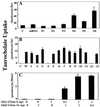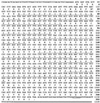Expression cloning of two genes that together mediate organic solute and steroid transport in the liver of a marine vertebrate
- PMID: 11470901
- PMCID: PMC55438
- DOI: 10.1073/pnas.161099898
Expression cloning of two genes that together mediate organic solute and steroid transport in the liver of a marine vertebrate
Abstract
Uptake of organic solutes and xenobiotics by mammalian cells is mediated by ATP-independent transporters, and four families of transporters have now been identified. To search for novel organic solute transporters, a liver cDNA library from an evolutionarily primitive marine vertebrate, the little skate Raja erinacea, was screened for taurocholate transport activity by using Xenopus laevis oocytes. In contrast to the organic anion transporters identified to date, a transport activity was identified in this library that required the coexpression of two distinct gene products, termed organic solute transporter alpha and beta (Ostalpha, Ostbeta). Ostalpha cDNA encodes for a protein of 352 aa and seven putative transmembrane (TM) domains. Ostbeta contains 182 aa and has at least one and perhaps two TM domains. There is no significant sequence identity between Ostalpha and Ostbeta, and only low identity with sequences in the databases; however, Ostalpha bears a resemblance to some G protein-coupled receptors, and Ostbeta exhibits 22% amino acid identity with the C-terminal TM and intracellular domains of protocadherin-gamma, a cell surface glycoprotein. Xenopus oocytes injected with the cRNA for both Ostalpha and Ostbeta, but not each separately, were able to take up taurocholate, estrone sulfate, digoxin, and prostaglandin E(2), but not p-aminohippurate or S-dinitrophenyl glutathione. Transport was sodium-independent, saturable, and inhibited by organic anions and steroids, including the major skate bile salt, scymnol sulfate. These results identify an organic anion transporter composed of a putative seven-helix TM protein and an ancillary membrane polypeptide.
Figures





References
-
- Kullak-Ublick G A, Stieger B, Hagenbuch B, Meier P J. Semin Liver Dis. 2000;20:273–292. - PubMed
-
- Borst P, Evers R, Kool M, Wijnholds J. J Natl Cancer Inst. 2000;92:1295–1302. - PubMed
-
- Keppler D, Konig J. Semin Liver Dis. 2000;20:265–272. - PubMed
-
- Suzuki H, Sugiyama Y. Semin Liver Dis. 2000;20:251–263. - PubMed
MeSH terms
Substances
Associated data
- Actions
- Actions
Grants and funding
LinkOut - more resources
Full Text Sources
Other Literature Sources

